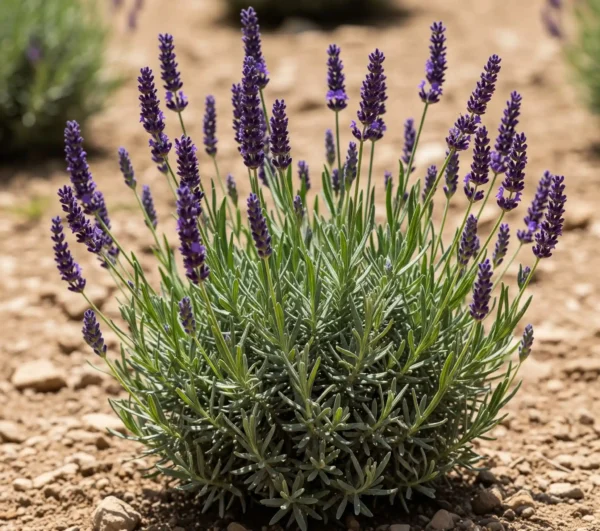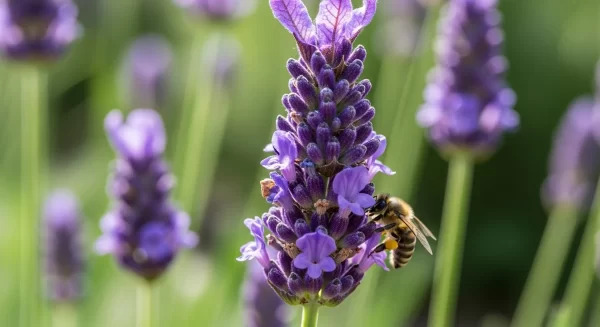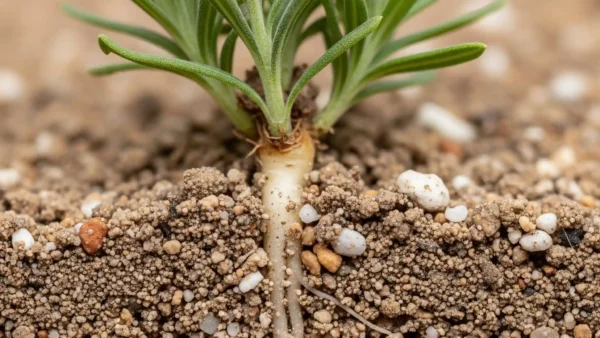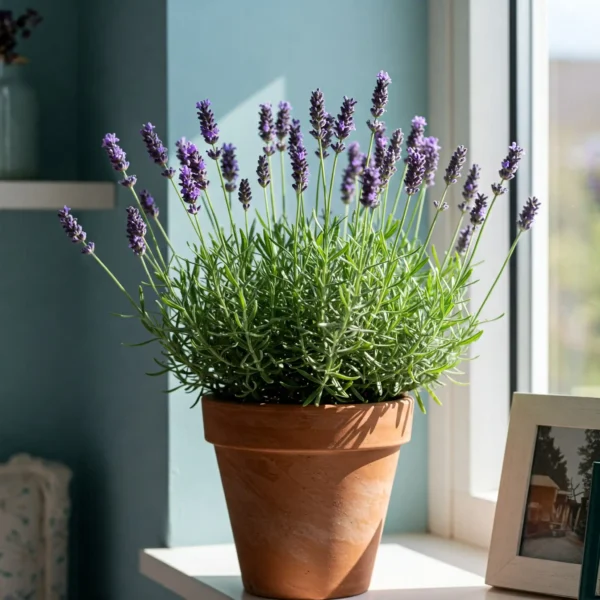Don’t Plant Your Lavender Yet: Read This First
From the nursery, you took home a lovely lavender plant bursting with potential and aromatic promise. Following all the guidelines, you have created the ideal sunny area with flawless, perfectly draining soil. Now comes the most important choice you will make—one that has nothing to do with soil or sun but everything to do with time: when do you really put it in the ground? Planting on the wrong weekend, or even in the wrong month, can make all the difference between a flourishing, long-lived lavender hedge that smells your whole garden and a plant that suffers from day one and never quite lives up to its promise.
TL;DR: The Lavender Planting Calendar
- For Most Climates (Cold Winters, Zones 3-6): The best and safest time to plant lavender is in the spring, several weeks after your average last frost date has passed and the soil has warmed to at least 55-60°F. This gives the plant the entire growing season to establish a strong root system before its first winter.
- For Mild Winter & Hot Summer Climates (Zones 7 and above): The better option is often fall planting, about 6-8 weeks before your average first frost date. This allows the plant to establish its roots during the cool, mild winter, making it much more resilient to the stress of its first hot summer.
- The Goal of Timing: The “when” is all about giving the lavender’s roots the longest, most stress-free window possible to grow strong before facing the extreme environmental stress of either summer heat or winter cold.
- Avoid Summer Planting: Planting in the heat of summer is generally not recommended. The plant will be forced to focus all its energy on surviving the heat rather than developing a healthy root system.
- Check Soil Temperature: For best results, use a soil thermometer. The ideal soil temperature for new root growth is between 55°F and 70°F (13°C – 21°C).
So let’s start straight forwardly and then delve into the interesting “why.” Spring is the best and safest season to plant lavender for the great majority of US regions; few weeks after the last frost passes and the soil will have warmed. Fall planting is frequently the better option, though, for individuals who cultivate in areas with moderate winters and very hot summers since it provides a strong head start for the next season.
The “when” is mostly about giving the roots of the plant the best possible opportunity to establish themselves before confronting the twin giants of environmental stress: summer heat and winter cold. This book is your strategic guidebook. It will show exactly how to interpret your local calendar and climate to find the ideal planting window, so ensuring that your lavender not only survives but thrives from the time it touches the ground.
All set to master timing your planting like a professional? Let’s match the seasons’ rhythm with our timepieces.
Beyond a Calendar Date: The Science of Planting Time
We must act like a plant if we are to really understand timing for planting. Ignore our human deadlines and calendar. In those first few fragile weeks in a new, strange house, what does a lavender plant require? The solution is straightforward and profound: roots cannot grow below earth without calm and quiet.
Realizing Transplant Shock
Moving a plant from its comfortable, sheltered nursery pot to the wide-open yard will always disrupt its fragile root system. The best root hairs, the microscopic workhorses in charge of the great bulk of water and nutrient absorption, break even with the most cautious handling. The plant reacts by entering a brief “pouting” phase in which it directs all of its energy toward healing this harm and attaching itself into its new home. Planting when the temperature is pleasant and the plant’s demands are minimal helps us as gardeners to make this recuperation period as short and stress-free as feasible.
The Essential Task of Root Development
For the first several weeks following planting, this is the sole duty the plant has. It is furiously creating a vast network of fresh roots to explore its new habitat and locate water and nutrients, not trying to create lovely flowers or lush leaves. A well-established root system is deep, strong, and broad, much as the basis of a well-built structure. It’s the architecture supporting everything that follows: drought tolerance, explosive development, lots of blossoms, and survival through a hard winter. Like a house with a weak foundation, a poorly established plant will struggle always, never quite fulfilling its great, beautiful potential.
Summer heat and winter cold are the two main forces upsetting this vital process. Strong heat drives the plant to redirect energy to survival activities like transpiration—basically, sweating through its leaves—just to stay cool, therefore depriving valuable energy from root development. Conversely, winter cold causes total cessation of root development. A plant cannot absorb the moisture required to survive drying winter winds if its root system is small and weak enough before the ground freezes, therefore causing its death. The “sweet spot” that offers a long, moderate window between these two extremes marks the ideal planting date.
The Hidden Ingredient: Dirt Temperature
Here’s a suggestion at expert level that will make all the difference: roots are most active in warm but not hot soil. See it like Goldilocks. Between 55°F and 70°F (13°C – 21°C), is the perfect soil temperature for promoting fresh root development. Planting in early spring, chilly soil means the roots will simply lie there, inactive and prone to decay in the moist ground. Planting in hot summer soil can literally fry the fragile fresh roots. One smart move that gives your lavender a running start is timing your planting to coincide with perfect soil temps. Any garden center should have a basic soil thermometer, which is a great tool for removing some of the guessing from the picture.
Spring into Action: Why Spring Is the Safest Bet for Lavender
For most gardeners—especially those new to lavender or residing in colder regions of the nation—spring planting is the gold standard and for very good reason.
- The main benefit of spring planting is that it allows the lavender plant the longest runway for growth—all of spring, all of summer, and all of fall—to create a deep and wide root system before its first-ever winter. Especially for gardeners in climates with severe winters (Zones 3-6), this large head start is a great insurance policy and makes spring planting the safest and most highly advised approach. The gardener also gains psychologically by being able to see his new plant thrive all season long, so boosting his confidence.
- The drawback is that the plant will be under stress from summer heat even as it is still establishing. This implies that throughout its first summer it will require more careful watering than a mature plant would. Not only once a week, be ready to inspect the ground every few days during a July hot. Furthermore, a spring-planted lavender will mostly store its first-year energy in its roots, hence the first-year floral display will probably be somewhat small. There will be a few beautiful blossoms, not a large exhibition. Patience; you are laying the groundwork for an amazing second year performance.
- The best time to plant is two to three weeks following your average last frost date. Don’t hurry it just because the neighborhood garden center carries current plants. A late cold snap can yet occur; that latest frost date is average. Waiting that additional couple of weeks lets the ground warm up and offers vital insurance. The ground is “awake” and ready to welcome your plant with the conditions it requires for vigorous root development when your soil thermometer routinely reads 55-60°F in the morning. Planting any sooner in damp, chilly soil is just asking rot.
The Fall Advantage: A Head Start for Blooms Coming Next Year
Fall planting is not only a great, smart move that can provide amazing benefits for some climates; it is also a necessary one.
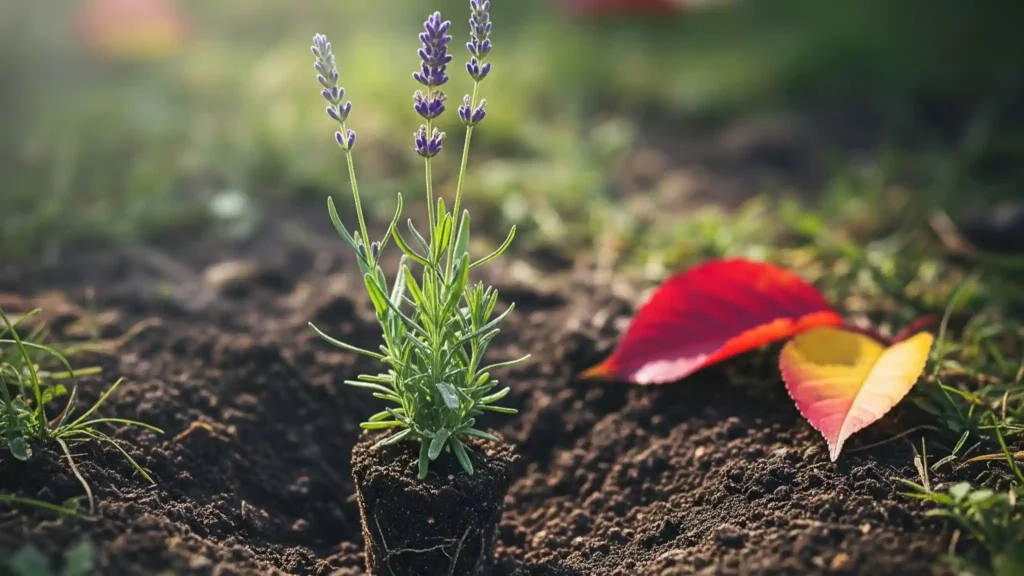
- For the correct gardener at the correct location, this is the pros level action. Imagine putting your lavender into ground still quite warm and pliable from the summer sun while the air is cool and clear. This mix lessens transplant shock rather much. Usually, gentle fall rain meets most watering requirements. The plant can devote all of its energy into one thing: explosive, invisible root growth; it is no longer concerned about making flowers or surviving summer heat. Usually looking like a strong second-year plant, a fall-planted lavender emerges spring ready to create a huge blossom show that will make your spring-planting neighbors jealous.
- The Cons: This approach demands respect since it represents a major risk. In chilly climates, this is a risk not worth running. Should you plant too late or if an exceptionally early and severe winter strikes, the roots won’t have nearly enough time to grow before the ground freezes, hence the plant will probably perish. Gardeners who are ready to pay close attention to the calendar and who know the rhythms of their environment will find this approach most suited.
- The critical window is completely non-negotiable. Lavender ought to be planted minimum six to eight weeks before your usual first frost date. Note this date on your calendar and work backwards to identify your planting window. For instance, your absolute final planting day should be about August 20th if your first frost usually falls on October 15th. A perennial requires the least amount of time to develop sufficient fresh roots to anchor itself and survive the winter. Any later is Mother Nature rolling the dice.
Timing Lavender Around the USA: Your Seasonal Planting Guide
Apply this science to your backyard anywhere you reside.
- Cold Winter Climates (Zones 3–6; Minneapolis, Chicago, Buffalo): The only secure choice, for you, is spring planting (usually late May to mid-June). A fall-planted lavender runs much too great a danger not establishing before a strong, deep freeze. Once the ground has really warmed up, plant after all risk of frost has passed and appreciate seeing it flourish all season long. Choose the toughest English Lavender cultivars, such as “Hidcote” or “Munstead,” which are more suited for cold.
- Temperate & Transitional Climates (Zones 7-8; Raleigh, Nashville, Seattle, Portland): You have a strategic choice and fall in the sweet spot. Perfectly safe and effective is spring planting (mid-April through late May). But if you are a conscientious planner, fall planting—early September to early October—is usually better, producing a substantially bigger and more floriferous plant the next year. This is a typical risk/reward situation with enormous potential pay-off. If you are planting in fall, pay close attention to the 10-day forecast and steer clear of planting just before an unseasonable cold snap is expected.
- Hot & Mild Winter Climates (Zones 9+; Orlando, Houston, Phoenix, much of California): Fall planting, October to November, is the highly advised, gold-standard method for gardeners in these areas. Autumn planting lets the lavender build its whole root system during the mild, comfortable, sometimes rainy winter months. This makes it hardy and prepared for the strain of its first terrible summer. In certain zones, spring-planted lavender might suffer greatly with the abrupt and early start of strong heat. Pro-Tip: Your lavender will still require full light to establish well before the days get too short even though you are planting in October.
The Propagation Calendar: Cuttings and Seed Starting Times
Timing is just as crucial if you are starting your lavender from scratch.
- Starting Seeds: This winter endeavor calls for some forethought. Starting your lavender seeds inside ten to twelve weeks before your usual last frost date will help. This long history explains their apparently delayed germination, their necessary cold stratification period, and their initial slow development into robust seedlings. Once the ground has warmed, this guarantees that you have good-sized plants ready to be hardened off and planted out in the spring. If your latest frost falls on May 15th, for instance, you should be planting seeds late February.
- Taking Cuttings: Softwood cuttings is best done in late spring or early summer from the fresh, robust growth of the season. The plant’s natural growth hormones are highest in the new stems at this time of year, hence the cutting is far more likely to produce roots. This timing also allows the new cutting the full summer to grow a strong root system in its pot, thereby enabling it to be planted out in the fall (in mild areas) or to withstand the winter in its pot before a spring planting.
Finish
Whether winter cold or summer heat, deciding when to plant lavender is a strategic choice motivated by one simple goal: providing the roots the longest, most stress-free period possible to establish themselves before confronting their first major hurdle. It is about working with the particular rhythm of your area, not against it.
Most gardeners find spring to provide a long and safe platform for development. A well-timed fall planting is a wise investment in the amazing show next year for those in milder regions. You are planning; you are not anymore wondering. Knowing when to plant lavender for your particular environment will help you to create a long-lived, fragrant, and healthy garden friend.
Often asked questions
I passed the spring window late. Could I start lavender in the summer?
Generally not advised and hazardous is it. The strong heat drives the plant to concentrate all its energy on just surviving—a process known as transpiration—rather than on developing new roots. This is like sweating. Should you really have to plant in summer, be ready to water it carefully and inspect the soil every other day during heat waves. More significantly, during the first few weeks, offer some temporary afternoon shade using a piece of shade cloth or even a well-placed patio chair to help to lower heat stress on the leaves and soil.
If I plant in a cold zone late in the fall, what happens?
The roots of the plant won’t have time to expand out and ground themselves into the surrounding earth. “Frost heave” is the process by which the ground freezes and thaws repeatedly over a winter. The movement of the earth can literally drive the unanchored root ball straight out of the ground, exposing the fragile roots to drying winds and destroying the plant.
Where are my first and latest frost dates found?
Consult the Farmer’s Almanac website or check with your local university cooperative extension office online. Just Google “frost dates for [your zip code].” Always keep an eye on the actual 10-day prediction as well before planting; these are averages based on 30 years of data.
Should I be planting in a pot, does the timing change?
Though they are arguably more important, the same ideas apply. In the summer, the soil in pots gets significantly hotter; in the winter, it freezes far faster and more solidly than protected ground soil. For maximum success, then, follow the recommended spring and fall planting windows. The roots of a newly planted lavender in a pot nearly have no protection from the high temperatures, hence avoid planting it during the height of summer or just before a heavy freeze is expected.





